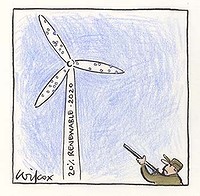Anti-Wind Energy Groups
A number of anti-wind energy groups appear to be front groups, particularly for the nuclear industry which sees wind energy as a competitor. There are now claimed to be some 230 anti-wind groups in the UK alone.
This is not to say that those who opposed wind power don't have legitimate concerns. However it is important to recognise that they are being supported by groups with vested interests as well as by global warming deniers.
 One prominent UK opponent of wind power is former television personality David Bellamy (pictured) who is also a climate change denier. Bellamy claimed in a 2005 letter to New Scientist that most glaciers were advancing rather than retreating, on the basis of information found on the website of global warming denial think tank, the Science and Environmental Policy Project (SEPP). He later joined the denial group, New Zealand Climate Science Coalition.
One prominent UK opponent of wind power is former television personality David Bellamy (pictured) who is also a climate change denier. Bellamy claimed in a 2005 letter to New Scientist that most glaciers were advancing rather than retreating, on the basis of information found on the website of global warming denial think tank, the Science and Environmental Policy Project (SEPP). He later joined the denial group, New Zealand Climate Science Coalition.
Anti-wind power front groups tend to exaggerate the problems associated with wind power.Opponents of a windfarm project on the edge of the Lake District National Park, which was to be one of the largest onshore wind farms in Europe, was found guilty, by the Advertising Standards Authority, of exaggerating the size, number and impact of wind turbines.

Country Guardian is a UK group that was founded in 1991 and campaigns against industrial wind turbines. It argues that they marr the landscape, are technologically flawed and are detrimental to the local environment. Country Guardian claims to have defeated many wind farm proposals in the UK.
The group's vice-president is Bernard Ingham, who also co-founded the group. Ingham, once press secretary to Margaret Thatcher, was a paid consultant for British Nuclear Fuels Plc (BNFL). He was also a director of Supporters of Nuclear Energy (SONE).
Sources at Country Guardian claim [in 2004] that they have stopped or postponed up to 89 per cent of planned wind farms in some years. Ingham has been credited with personally thwarting 80 per cent of applications.
 There are several anti-wind power groups in the UK and Australia that use the name Coastal Guardians or Landscape Guardians. These groups tend to use the tactics of Country Guardian and also the information and arguments that Country Guardian supplies. Many of these groups may well be genuine citizen's groups.
There are several anti-wind power groups in the UK and Australia that use the name Coastal Guardians or Landscape Guardians. These groups tend to use the tactics of Country Guardian and also the information and arguments that Country Guardian supplies. Many of these groups may well be genuine citizen's groups.
One group is Coastal Guardians of Victoria, which works closely with David Bellamy. Its spokesperson, Tim Le Roy, makes contestable statements such as that environmental groups are divided over support for wind power. He claims wind power would not work because of the need for back-up power. However the national grid provides that back-up power. He claims theat there is no effective way to store electricity from wind turbines, but this is true of most energy sources including coal.
Tim Le Roy has also been spokesperson for Tarwin Valley Coastal Guardians, and other anti-wind groups, although he seems to live in the inner suburbs of Melbourne. Another is Landscape Guardians in Taralga, NSW, whose president, Paul Miskelly, worked for the Australian Nuclear Science and Technology Organisation (ANSTO) for three decades. The president of another anti-wind group, the Waubra Foundation, is Peter Mitchell, a former director of oil and gas companies.
In Australia, the leading opponents are the Waubra Foundation and the Australian Landscape Guardians, which share a post office box with a mining investment company, Lowell Resources. Australian Landscape Guardians has been totally silent on any other intrusion on the landscape, apparently unperturbed by mining, highway construction or suburban encroachment.
The front group, Australian Environment Foundation (AEF) is also opposing wind power. According to the AEF, since humans are not causing climate change, wind farms are an expensive indulgence. The Shooters and Fishers Party has also called for a moratorium on wind farms.
As the result of these activist groups most of the media coverage of wind farms is negative. However results of a peer-reviewed study, published by the CSIRO, showed that there is strong support for wind farms in rural communities.